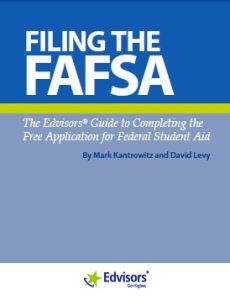
Every year, 20 million families file the Free Application for Federal Student Aid (FAFSA) and plenty of them inadvertently make costly mistakes.
To avoid the same fate, I’d urge you to check out the Edvisors Network’s free 201-page guide, entitled Filing the FAFSA. The guide, which you can download from Edvisors’ website, provides advice on how to maximize eligibility for financial aid, avoid common errors and complete the form 
Mark Kantrowitz, who is probably the nation’s most famous financial aid expert, wrote the guide along with David Levy, who is the former financial aid director for Scripps College, Occidental College and Cal Tech.
Today I’m sharing the pair’s advice on which assets should be ignored when completing the FAFSA:
Assets You Shouldn’t Report On the FAFSA:
Retirement assets
Never report money invested in qualified retirement accounts, such as Individual Retirement Accounts, 401(k) plans, 403(b)’s, SEP-IRA’s and pension plans on the FAFSA.
If you pull money out of any of these retirement accounts, however, this money must be treated as income on the FAFSA.
Home equity
The FAFSA doesn’t ask you if you own a primary home so you could live in a palatial estate and it wouldn’t impact your chances for financial aid.
The CSS/Financial Aid PROFILE, which 250 mostly private colleges and universities use, does inquire about home equity, but individual schools will treat this asset quite differently. To learn more, read my previous posts:
Will Your Home Equity Hurt Financial Aid Chances: A Case Study
Is It Okay to Hide Home Equity?
A home equity line of credit is not reported as an asset on the FAFSA or the PROFILE unless the borrower has pulled money from the line of credit and has not spent this cash at the time the financial aid applications are completed.
Life insurance policy
The FAFSA doesn’t consider cash value life insurance as an asset. Because of this omission, some insurance agents like to peddle cash value life insurance as a way to hide parents’ assets. There are many reasons why you should stay away from so-called experts who make this suggestion.
As Kantrowitz and Levy note in their guide: “The high sales commissions, high premium, low return on investment, the nondeductible nature of the premiums and the surrender charges, among other problems, may cost the family more than they save from sheltering the money from the need-analysis process.”
In addition, going to all this trouble to hide assets is not only expensive, but usually unnecessary. To learn why, check my previous college blog post on this topic:
Why College Savings Usually Doesn’t Hurt Financial Aid Chances
One more thing about life insurance: settlements from a life insurance policy will count as income.
Family business
The FAFSA also doesn’t consider assets in a small business that a family owns and controls. The small businesses must have less than 100 full-time or full-time equivalent employees. To be controlled by the family, t he family must own more than 50% of the business. The family member may include relatives by birth or marriage.
The PROFILE will want to know about business assets, but what the schools do with this information will vary by institution.
Family farm
The FAFSA doesn’t want to know about assets in a farm if it is the family’s principal residence and the student and/or parents materially participate in the farming operation. The PROFILE will ask about a family farm, but once again schools will treat this asset will vary.

There was a life insurance policy opened in the 80s for my step father and I was the owner at a young age. Complicated divorce issues did not allow me to withdraw over a 4 year period of time and the value of the whole life policy went to a spiraling loss of 25K. So the cost basis was not considered income per the tax person and a loss of 25k of the original deposit. Does this need to be reported even though it was a loss?
Do we have to report money in a money market. Or emergency fund?
Author
Yes you do.
Lynn O
What about health savings plans?
Author
The contributions to a health savings plan must be reported on the FAFSA as untaxed income.
Lynn O’Shaughnessy
I could not disagree more when it comes to your assessment of how the life insurance variable fits into the overall equation. Your comments suggest to me that you have never seen a quality life insurance product.
First of all, it should be noted that whole life insurance is not an investment. It is however a savings vehicle. It is important to make this distinction because investments have risk associated with them, whereas savings vehicles do not.
As for the “low return on investment” that you mention, how does a 7.10% Dividend sound?
The board of Directors for the Massachusetts Life Insurance Company declared a 7.10% dividend for 2016. All whole life insurance policyholders would be eligible to collect their portion of that 7.10% dividend, and it should be noted that is the third year the company has had the highest dividend in the industry. Of course after you deduct fees and expenses, policyholders are looking at an ultimate rate of return between 5% and 6%, and that is with absolutely no risk in the market.
The kicker of course is what the market did in 2015. Anyone who had a 529 college savings plan probably lost money in 2015.
As for the “nondeductible nature of the premiums,” Whole Life Insurance has the same tax treatment as a Roth IRA. Many investors that I have talked to over the years find the tax treatment associated with Roth IRAs particularly attractive because there is no guarantee that tax rates will remain the same between now and their projected retirement date. If tax rates do change between now and then, it’s a pretty safe bet that they will be going up, not down. Just look at our national debt. The money has to come from somewhere. I personally would rather pay my taxes up front and then have the peace of mind that comes with the knowledge that Uncle Sam can never again touch the money in that particular savings vehicle.
The beautiful part about it is that there are no maximum income restrictions on Whole Life Insurance products and there are no maximum contribution limits either. The only thing you have worry about is whether or not your life insurance policy will become a MEC because Modified Endowment Contracts do not offer the tax shelter that life insurance would otherwise offer.
As for “settlements from a life insurance policy,” why would you ever surrender the policy when you could simply surrender your Paid Up Additions, which you would accumulate from receiving tax free dividends from the insurance company? Furthermore, why would you ever surrender the policy when you could simply take tax free loans from your policy Cash Value up to your cost basis without creating a taxable event?
Lastly, if an individual is a parent, then their child or children inherently create a need for life insurance. Any parent who cares about completing their financial goals in the event that they are no longer around would have a need to take out a life insurance policy, particularly if one of their financial goals is getting their child or children through college.
I have just finished working on the 2015-2016 Fafsa and I have not included my retirement income since I found nowhere on the form where it should be entered. It is not a W2, so where on the Fafsa should it be entered? Or should it? This is a state employee pension that I contributed to for 39 years.
Thanks for any help,
George